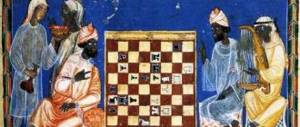Is there a connection between chess and mathematics? — Bulatova E — 4th grade
| Regional scientific and practical conference “New generation of Kuraginsky district” for grades 4, 5, 6 | |
| Job title | Is there a connection between chess and mathematics? |
| Surname, first name of the author (team of authors) | Bulatov Alexander |
| Territory | District Kuraginsky Kuragino village |
| Place of study: | Municipal educational institution Kuraginskaya secondary school No. 1 |
| Class | 4B |
| Place of work | School scientific society of students “Cognition” |
| Supervisor | Bulatova E.V. |
| The role of the leader | Assistance in selecting information and completing work. |
| Contacts |
Is there a connection between chess and mathematics?
Goal: to trace the connection between chess and mathematics.
Tasks:
— get acquainted with the history of chess;
- find out what chess patterns are;
— study chess studies and problems, positions and combinations.
I have been playing chess for two years now and one day I heard a very interesting story that I want to tell you.
When the Indian king first became acquainted with chess, he was delighted with its originality and abundance of beautiful combinations. Having learned that the sage who invented the game was his subject, the king called him to personally reward him for his brilliant invention. The king promised to fulfill any request of the sage and was surprised by his modesty when he wished to receive a grain of wheat as a reward. The first field of the chessboard has one grain, the second field has two, each subsequent field has twice as many grains as the previous one. The Tsar ordered to quickly give the inventor of chess his insignificant reward.
The maharajah's accountants worked all night and only in the morning they informed their master that his command was impossible to fulfill: there was simply no such amount of grain not only in all of India, but also in the entire earth. In total, the formidable ruler needed to get 18 quintillion 446 quadrillion 744 trillion 073 billion 709 million 551 thousand 615 grains.
To fulfill this modest request of the sage, it would take 280,000 years in a row to collect all the crops grown in India, or for 8 years to sow and collect grain from the entire surface of the Earth. And if you build a barn for it with a height of four and a width of ten meters, then it would be 300,000,000 kilometers long, or from the Earth to the Sun and back.
I liked the legend so much that I decided to find out if there was any other connection between chess and mathematics. I'll start with history...
History of chess
Chess was invented around 1000 BC by an Indian mathematician who also invented the mathematical operation of exponentiation. There is no mention of this game in literature before 570 AD, so many historians consider this date to be the birth of chess.
Chess was brought to Western countries by Muslims, who conquered the territories of India, Persia, and Spain. Chess was brought to Spain by the Moors, and the first mention of chess in Christendom is in the Catalan Testament of 1010 AD. Although chess was known in Europe in earlier times. There is a poem that describes how chess was played at the court of King Arthur. Excavations in Novgorod say that chess, which was spread by the Arabs, came to Russia from the Middle East.
In ancient Russian folk poems there are references to chess as a popular game. There is a version that chess was brought to Russia during the Tatar-Mongol invasion. Chess was banned in Europe by the Church for some time, as it was often used to play for money. However, the game became popular, this is confirmed by numerous literary evidence.[2, p.48]
- Chessboard mathematics
Symmetry
One of the laws of chess is symmetry.
“Symmetry, no matter how broadly or narrowly we understand this word, is an idea with the help of which man has tried for centuries to explain and create order, beauty and perfection,” wrote the German mathematician Hermann Weyl. In everyday life, we constantly come across one or another symmetry motif. Ornaments, mosaics, and decorative patterns delight our eyes with the symmetrical arrangement of the pattern. The composition of many engravings by the famous Dutch artist Escher (including those with a chess plot) is dominated by symmetry. [1, p. 63]
Various symmetry motifs are also found on the chessboard. On the one hand, we can talk about natural symmetry, that is, arising in the process of a chess game, and on the other hand, it can be used in chess problems and studies.
A chessboard is a square divided into 64 squares, and any square has 4 axes of symmetry, which means that a chessboard also has 4 axes of symmetry.
The horizontal and vertical axis divide our chessboard into symmetrical figures, only the squares will have different colors. The axes passing through the diagonals of the chessboard divide it into symmetrical figures with the same color.
All these axes intersect at one point, and this point is called the center of symmetry.
When playing chess, I noticed that some unusual chess games and positions are related to symmetry.
There is such a funny story. Someone came to the chess club and announced that he had found a sure way not to lose with black. "How?" - they asked him. “Very simple,” the guest replied, “by repeating the enemy’s moves!” S. Lloyd volunteered to play with the naive inventor, who declared checkmate to him in 4 moves. It is unclear how Lloyd did this. I can checkmate in 6 moves with complete symmetry of the pieces.[3, p.76]
Let me remind you that symmetry comes in different types; the most common are axial and central.
On a chessboard with axial symmetry, the axis is the straight line separating the left and right flanks of the board (the border between the verticals “d” and “e”) or the lower and upper parts (the border between the fourth and fifth horizontals).
The initial arrangement of chess pieces has symmetry. The ancient opening games (positions from which the game begins), for example “almujannah”, are also symmetrical. [1, p.26]
2.2 Even and odd
The next pattern is Even and Odd.
Number is one of the basic concepts of mathematics, allowing one to express the results of counting or measurement. Over time, people learned not only to name numbers, but also to designate them with numbers (conventional signs for indicating numbers).
The numbers 0, 2, 4, 6, 8 are called even, and the numbers 1, 3, 5, 7, 9 are called odd. From the test of divisibility by 2 it follows that natural numbers that are divisible by 2 are called even, the rest are called odd.
On the chessboard there is also even and odd, here it is associated with the move number.
With each move, the king changes the parity of the square on which he stands. For example, the first move is odd, the second is even, etc. At the same time, the king changes the color of the square on which he stands.
2.3 Coordinate system
A coordinate system is a description of where a particular object (object, place) is located.
In the speech of adults we can hear the following phrase: “Leave me your coordinates.” This expression means that the interlocutor must leave his address or telephone number, which in this case are considered the coordinates of the person and using this data he can be found.
This is precisely the essence of coordinates or, as they usually say, coordinate systems - the rule by which the position of an object is determined.
Coordinate systems permeate the entire practical life of a person. In addition to postal addresses and telephone numbers, we are familiar with the coordinate system in the cinema auditorium (row number and seat number), on the train (car number and seat number), with the geographic coordinate system (longitude and latitude), etc.
In mathematics, a coordinate system is introduced on a plane if a method is specified that allows one to unambiguously establish the position of all points on the plane using numbers.
Such a system is called a rectangular coordinate system. It is determined by two mutually perpendicular straight lines Ox and Oy on which positive directions (indicated by arrows) and a scale for measuring lengths are selected.
I place the chessboard along the axis Ox - letters, Oy - numbers.
The coordinate system is also used in chess. The horizontal lines on a chessboard are designated by Latin letters, and the vertical lines by numbers.
Conclusion
Chess is one of the most ancient games. It has existed for many centuries, and it is not surprising that various legends are associated with it, the veracity of which, due to the length of time, cannot be verified.
While doing this work, I became acquainted with the history of chess. Ahead of the school mathematics course, I learned what symmetry, even and odd, and a coordinate system are. I learned to solve many interesting and entertaining problems.
Therefore, I believe that there is a connection between chess and mathematics.
Bibliography:
- E. Ya. Gik. Chess and mathematics. - M., Nauka, 1983.
- M. Gardner. Mathematical miracles and secrets - M., Nauka, 1978.
- S. Lloyd. Mathematical mosaic - M., Mir, 1984.
- A.P. Savin. Encyclopedic Dictionary of a Young Mathematician - M., Pedagogy, 1989.
Similar articles:
Job descriptions → Job description of a librarian
News → Open day in first grades
Job descriptions → Job description of a primary school teacher
News → All-Russian reading competition “Living Classics”
Interim certification → Literature



